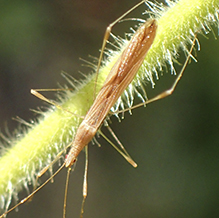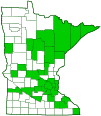Stilt bugs
(Family Berytidae)
Overview • Description • Distribution • Taxonomy

Overview
Berytidae is a family of fairly common, small to medium-sized, extremely slender, true bugs known as stilt bugs or thread bugs. They are found worldwide on all continents except Antarctica. They are common in Europe and North America, but uncommon to absent in northern and central Africa and in northern Asia. There are about 200 species in 13 genera in 3 subfamilies worldwide, about 50 species in 13 genera in the New World, 12 species in 8 genera in North America north of Mexico, and at least 4 species in 3 genera in 2 subfamilies in Minnesota.
Stilt bugs are found in a variety of habitats, including forests, grasslands, and deserts.
Most stilt bugs feed on the sap of plants. Many species specialize in plants with sticky, glandular hairs, and have developed split or toothed claws to help them deal with that plant defense. Some species feed on mites and small insects that have become trapped on the sticky hairs. Some species feed on the eggs of moths.
Description
Stilt bugs worldwide are small to medium-sized, 1⁄16″ to ⅝″ (2 to 16 mm) in length, not including the legs. However, all of the species that occur in North America are small, 3⁄16″ to ⅜″ (5 to 9 mm) in length. The body is slender, cylindrical, and on most species, brownish.
The head is long and there is a distinct neck. There are two compound eyes and two simple eyes (ocelli). The mouthparts are optimized for piercing and sucking and formed into a beak with four segments. The antennae are long and slender and have four segments. On most species they are elbowed. The first segment is very long. The fourth segment is short and obviously expanded, spindle shaped.
The abdomen is long and slender and has ten segments.
Most species have fully developed wings, some have reduced wings or no wings at all. When present, the wings are held roof-like over the body when at rest. The forewing has five veins.
The legs are long and slender. The hind legs are very long, much longer than the front legs. This is the feature that gives the family its common name. The fourth segment (tibia) on the front legs is unarmed, having no spines. The last part of each leg (tarsus), corresponding to the foot, has three segments.
Distribution |
||
|
Sources Biodiversity occurrence data published by: Minnesota Biodiversity Atlas (accessed through the Minnesota Biodiversity Atlas Portal, bellatlas.umn.edu, 10/6/2025). |
|
| 10/6/2025 | ||
Taxonomy
Order
Hemiptera (True bugs, Hoppers, Aphids, and Allies)
Suborder
Heteroptera (True Bugs)
Infraorder
Pentatomomorpha
Superfamily
Lygaeoidea (seed bugs and allies)
Subordinate Taxa
Subfamily Berytinae ![]()
![]()
Subfamily Gampsocorinae ![]()
Subfamily Metacanthinae ![]()
![]()
Synonyms
Neididae
Common Names
stilt bugs
Glossary
Ocellus
Simple eye; an eye with a single lens. Plural: ocelli.
Tarsus
On insects, the last two to five subdivisions of the leg, attached to the tibia; the foot. On spiders, the last segment of the leg. Plural: tarsi.
Tibia
The fourth segment of an insect leg, after the femur and before the tarsus (foot). The fifth segment of a spider leg or palp. Plural: tibiae.
Visitor Photos
Share your photo of this insect.
This button not working for you?
Simply email us at info@MinnesotaSeasons.com.
Attach one or more photos and, if you like, a caption.
|
||
MinnesotaSeasons.com Photos
|

Slideshows
Stilt Bug (family Berytidae)
Andree Reno Sanborn

Visitor Videos
Share your video of this insect.
This button not working for you?
Simply email us at info@MinnesotaSeasons.com.
Attach a video, a YouTube link, or a cloud storage link.
Other Videos
Berytidae, Bosque Lassen, Estados Unidos 202008
Z Y
Berytidae
mohamed moumaris

Visitor Sightings
Report a sighting of this insect.
This button not working for you?
Simply email us at info@MinnesotaSeasons.com.
Be sure to include a location.
Kerrie
10/5/2025
Location: Rancho Cucamonga, CA USA
lived here my whole life. I've never seen an insect like this before.
MinnesotaSeasons.com Sightings

